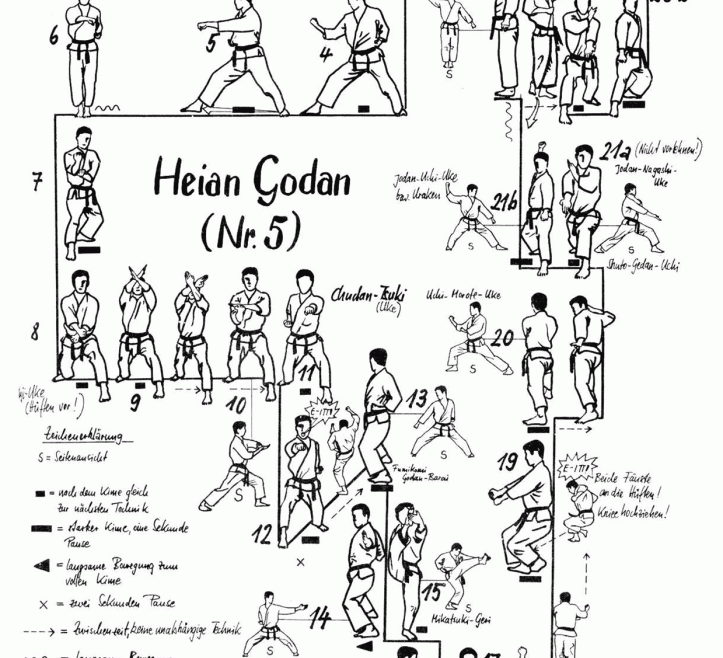
The kanji above reads in Japanese as “en-bu-sen,” or as it’s normally pronounced as a complete word, “embusen.” (It’s just easier to pronounce “em” in the word than “en.”) Japanese karate players recognize this word as referring to the path or pattern that your steps take when you’re performing a kata. If someone was watching you do your kata from above, what path would your steps trace on the floor as you do the whole routine? That path is the embusen.
In Shotokan karate, the modern kata were designed, or altered from older forms, so that your starting point and your ending point are the same — if you’ve done it correctly. When karate was transmitted from Okinawa to Japan in the early 20th century, when it changed from “Chinese hand” to “empty hand,” and when the Japanese applied their usual obsessive perfectionism to it, it became very important that your stances and steps (as well as your techniques) be always precise and correct. Therefore, having the kata begin and end at the same place gives the instructor a way to gauge the correctness of the student’s stances when they are performing the kata.
Did I say “perform”? That brings me to the point of this post. I always tell my students that kata, at least in Shotokan, don’t really look like or simulate a fight. Like everything else we do, a kata is a drill and it has its own purposes. But I tell them that kata is also performance. You may be doing it for tournament judges, your sensei, other students, or just for yourself — in any case, you’re performing. It’s a demonstration of your powers.
Guess what? “Performance” is in the meaning of the kanji for embusen. Of course, words have more than one meaning or nuance when translated between languages. However I am certain that I’m on solid ground to translate embusen the following way:
演 – en or em — performance, act, play
武 – bu — military or martial, as in “martial arts”
線- sen — line, route, outline, form
So, the embusen of your kata is the form, or the lines, of your martial performance.
In late March, all of our students moved from training in the dojo to training at home over Zoom. By now, some have returned to the dojo, and others are still at home. Some have held up better during these months than others. I have one student in particular whose karate has flourished during the last 3+ months. Of course, we are very limited in what we can practice. No falling practice, no self-defense or bunkai, no ippon kumite or randoori, no hitting focus mitts, kicking shields, or bags. But within the narrow confines of what we can do, this student, who is still very young, has improved substantially.
The student’s karate is distinguished by the tenacious spirit she brings, the precision of her moves and steps, and the “pop” in her do-gi at the completion of techniques. I had been trying to find the way to describe why it’s such a pleasure to watch her perform. At first I called it “old time karate.” (Like “old time hockey” from “Slapshot” :-])
But that’s not really what it is. Karate has changed so much that we would hardly recognize “old time karate” if we saw it. When I remembered the meaning of embusen, then I found the words for this student’s karate. I told her recently that when I watch her do kata, I feel like I’m seeing a martial performance. The most peaceful and gentle person in the world should look like, and feel themselves to be like, a warrior when they are performing their kata. That is one of the heights that we climb toward on this path.
====================================
OK, this is off-topic, but… “old time hockey” from a great movie:


